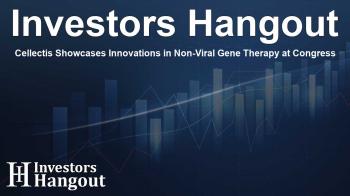Cellectis Showcases Innovations in Non-Viral Gene Therapy at Congress

Exciting Advances in Gene Therapy by Cellectis
Cellectis, a clinical-stage biotechnology company, is making headlines with its innovative approach to gene therapy, particularly in the exciting world of gene editing. Recently, the company announced significant findings regarding the potential of circular single-stranded DNA (CssDNA) as a universal non-viral template for gene therapies. These findings will be presented at the European Society of Cell and Gene Therapy (ESGCT) annual congress.
Details of the Presentation
One of the highlights of Cellectis' presentation is the poster titled "Circularization of Single-Stranded DNA Donor Template Unleashes the Power of Non-Viral Gene Delivery for Long-Term HSCs editing," to be presented by Julien Valton, Ph.D., Vice President of Gene Therapy.
Key Aspects of the Research
This innovative research emphasizes the use of CssDNA for gene editing, showcasing its effectiveness in hematopoietic stem and progenitor cells (HSPCs). Over the last decade, the non-viral DNA template has been utilized with engineered nucleases, but Cellectis has taken this a step further by expanding its application.
Research Findings and Efficacy
The results from the research are compelling:
- CssDNA shows a high gene insertion frequency within viable HSPCs.
- In murine models, CssDNA-edited HSPCs demonstrate superior engraftment and retention of gene edits compared to those edited using adeno-associated viruses (AAV).
These findings underline the promise of CssDNA as an effective tool in the realm of gene therapy, poised to transform therapeutic approaches.
Exploring TALE Base Editors
Another significant aspect of Cellectis' work involves TALE base editors (TALEB). These editors play a crucial role in genome editing without necessitating a DNA break. Maria Feola, Ph.D., Senior Scientist at Cellectis, will present on the "Comprehensive analysis of TALEB off-target editing."
Understanding TALEB Mechanism
The TALEB technology combines several advanced elements, including a transcription activator-like effector and a deaminase, providing a refined method for editing double-stranded DNA. Key to its success is the ability to minimize off-target effects, which remains paramount in developing safe therapeutic applications.
Evaluating Safety and Effectiveness
In assessing the safety of TALEB, Cellectis employed advanced bioinformatics alongside multiple experimental approaches. The study showed no inclination toward off-target C-to-T editing at critical sites, laying a robust foundation for future development and application in therapeutic cell engineering.
About Cellectis
Cellectis is recognized for its pioneering efforts in the biotechnology sector, utilizing an allogeneic strategy for CAR T immunotherapies in oncology. By focusing on ready-to-use gene-edited CAR T-cells, Cellectis aims to provide effective treatments for cancer patients, broadening its research into other therapeutic avenues as well. The company’s commitment to an end-to-end approach in gene editing demonstrates its dedication to control across the entire value chain of cell and gene therapy.
Company Contacts and Further Information
Cellectis maintains its headquarters in Paris, France, with additional locations in New York and Raleigh, NC. As a publicly traded company, it operates on Nasdaq under the ticker symbol CLLS. For more about their innovative research and developments, it is advisable to visit their official website or connect via their social media platforms.
Frequently Asked Questions
What is Cellectis' main area of research?
Cellectis focuses on gene editing and gene therapy applications, particularly in the treatment of cancer through CAR T-cell therapies.
Where will the ESGCT Congress take place?
The congress will host multiple presentations highlighting new research and advancements, taking place in Sevilla.
What are TALE base editors?
TALE base editors are specialized tools utilized for precise genome editing, enabling direct conversion of DNA bases without creating breaks in the DNA strands.
What are the advantages of using CssDNA in gene therapy?
CssDNA provides a versatile and efficient non-viral delivery method for gene editing applications, showing promising results in HSPC editing.
How can I learn more about Cellectis' research?
Further details can be found on Cellectis' official website, where they share research publications and company news.
About The Author
Contact Hannah Lewis privately here. Or send an email with ATTN: Hannah Lewis as the subject to contact@investorshangout.com.
About Investors Hangout
Investors Hangout is a leading online stock forum for financial discussion and learning, offering a wide range of free tools and resources. It draws in traders of all levels, who exchange market knowledge, investigate trading tactics, and keep an eye on industry developments in real time. Featuring financial articles, stock message boards, quotes, charts, company profiles, and live news updates. Through cooperative learning and a wealth of informational resources, it helps users from novices creating their first portfolios to experts honing their techniques. Join Investors Hangout today: https://investorshangout.com/
The content of this article is based on factual, publicly available information and does not represent legal, financial, or investment advice. Investors Hangout does not offer financial advice, and the author is not a licensed financial advisor. Consult a qualified advisor before making any financial or investment decisions based on this article. This article should not be considered advice to purchase, sell, or hold any securities or other investments. If any of the material provided here is inaccurate, please contact us for corrections.

